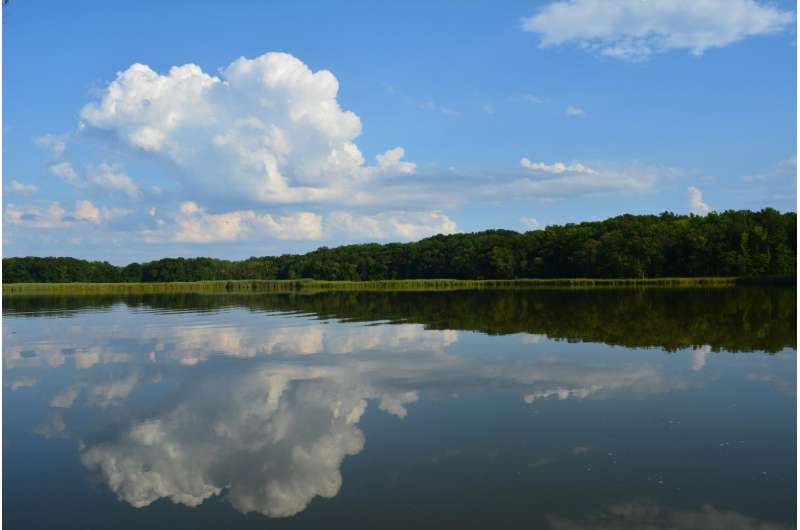This article has been reviewed according to Science X's editorial process and policies. Editors have highlighted the following attributes while ensuring the content's credibility:
fact-checked
peer-reviewed publication
trusted source
proofread
Rapid plant evolution may make coastal regions more susceptible to flooding and sea level rise, study shows

Evolution has occurred more rapidly than previously thought in the Chesapeake Bay wetlands, which may decrease the chance that coastal marshes can withstand future sea level rise. Researchers at the University of Notre Dame and collaborators have demonstrated this in a recent publication in Science.
Jason McLachlan, an associate professor in the Department of Biological Sciences, evaluated the role evolution plays in ecosystems in the Chesapeake Bay by studying a type of grass-like plant, Schoenoplectus americanus, also called chairmaker's bulrush. The research team used a combination of historical seeds found in core sediment samples, modern plants, and computational models to demonstrate that "resurrected" plants were allocating more resources in their roots below ground, allowing them to store carbon more quickly than modern plants.
"We think this surprising reduction in below-ground growth might be a response to increased pollution in Chesapeake Bay," McLachlan said. "Decades of pollution have resulted in higher levels of nitrogen and phosphorus in the waters, and since these are plant nutrients, evolution might now favor plants that 'invest' less in expensive roots."
The seeds from the historical plants had remained underground on the property of the Smithsonian Environmental Research Center on the bay, dormant since the mid-1900s. McLachlan and other researchers collected them and allowed them to germinate and grow. Known as resurrection ecology, this type of research provides direct evidence that can support assumptions about evolutionary change.
Computational models had previously established the threat of sea level rise to coastal wetlands, and have incorporated scientists' understanding of how flooding affects plant growth and how plant growth affects stability. While modern plants and samples from the mid-1900s grew similarly above ground, the modern plants invested less resources into rooting deeper below ground. This created less biomass below ground and could reduce the capacity of wetlands to withstand flooding.
McLachlan and collaborators showed, through computational models, that the modern plants store carbon in soils 15 percent slower than the plants did in the mid-1900s.
McLachlan was astounded by the speed with which evolutionary change occurred in Schoenoplectus americanus. "The research shows the role evolution plays as ecosystems are increasingly stressed by the impacts of human society," he said.
First author Megan Vahsen, a doctoral student at Notre Dame, had discovered the importance of below-ground plant traits as early as 2017 as a first-year graduate student at Notre Dame. Though the researchers cannot specifically say that plants are investing relatively more of their energy above ground and less below ground because of pollution, she believes the combination of techniques used in the current research provides novel predictions about the impact of evolution on ecosystems. She expects the study will motivate researchers to study the causes that drive evolutionary change.
"For reasons of inconvenience, science has often ignored what happens below ground," she said, noting that she and undergraduates at Notre Dame spent about 500 hours washing and sorting plant roots. "But we have learned so much in this study; there are so many secrets happening below ground."
McLachlan said the research further demonstrates the role evolution plays as ecosystems are increasingly stressed by the impacts of human society.
"Evolutionary change over almost a century played a destabilizing role for coastal ecosystems. Other species in other ecosystems might have responded differently to human environmental impact, perhaps providing more resilience to ecosystems, or perhaps having no impact at all," he said. "Now that we've shown that evolutionary change can be fast enough and large enough to affect ecosystem resilience, we hope other researchers will consider this component of biological response to global environmental change."
Other collaborators in this research include Michael Blum and Scott Emrich of the University of Tennessee; Jim Holmquist and Patrick Megonigal of the Smithsonian Environmental Research Center; Brady Stiller of the University of Notre Dame; and Kathe Todd-Brown of the University of Florida, Gainesville.
More information: M. L. Vahsen et al, Rapid plant trait evolution can alter coastal wetland resilience to sea level rise, Science (2023). DOI: 10.1126/science.abq0595
Journal information: Science
Provided by University of Notre Dame

















